The global high-power microwave source market is valued at USD 541.6 million in 2025 and is projected to reach USD 1,682.1 million by 2035, expanding at a CAGR of 12.0% with a 3.11X growth trajectory during the period, and within this expansion, diversification beyond defense presents a major opportunity. While defense radar systems and electromagnetic pulse generation remain primary use cases, nuclear fusion and high-energy physics laboratories are becoming large-scale consumers of HPM sources, particularly klystrons and gyrotrons used in plasma heating at facilities like ITER, with more projects across Europe, the US, and Asia increasing procurement levels. Research institutes focusing on particle acceleration and advanced material studies are also driving investments, creating a secondary but highly specialized demand cycle. Industrial applications are gaining momentum as microwave-driven plasma generation is used in semiconductor fabrication, nanomaterials, and surface modification, while sterilization and decontamination through high-power microwaves is gaining traction in food safety and medical device processing, offering faster throughput compared with chemical methods.
Material processing through localized heating of metals, ceramics, and composites is another fast-growing subsegment, particularly as aerospace and automotive sectors demand enhanced structural properties. Aerospace and space testing represent another major diversification angle, with satellite payload validation, antenna testing, and spacecraft component verification creating requirements for compact, high-frequency HPM systems, and early-stage exploration of space-based microwave power transfer suggesting long-term application scaling. Non-lethal systems for homeland security and law enforcement are also emerging, with prototypes targeting counter-drone defense and perimeter protection using directed energy at microwave frequencies, which are considered scalable alternatives to traditional kinetic systems.
Though adoption is still limited, regulatory easing and live demonstrations are improving acceptance, especially in the US and Middle Eastern markets. In parallel, wireless energy transfer using HPM sources is being trialed in research linked to space-based solar power, which could become commercially viable within the forecast horizon. Across all these diversification fronts, the industry is seeing a shift in procurement logic, as buyers in research, aerospace, and industrial segments require not just raw power output but higher efficiency, frequency stability, and compatibility with existing infrastructure, pushing manufacturers to innovate beyond defense-focused specifications.
Between 2025 and 2030, the high-power microwave source market is projected to expand from USD 541.6 million to USD 852.2 million, resulting in a value increase of USD 310.6 million, which represents 27.2% of the total forecast growth for the decade. This phase of development will be shaped by increasing adoption of solid-state microwave technologies, rising demand for high-frequency radar applications, and growing emphasis on advanced electromagnetic warfare systems with enhanced power output characteristics. Defense contractors are expanding their microwave source capabilities to address the growing demand for electronic warfare applications, radar modernization, and next-generation communication requirements.
| Metric | Value |
|---|---|
| Estimated Value in (2025E) | USD 541.6 million |
| Forecast Value in (2035F) | USD 1,682.1 million |
| Forecast CAGR (2025 to 2035) | 12.0% |
From 2030 to 2035, the high-power microwave source market is forecast to grow from USD 852.2 million to USD 1,682.1 million, adding another USD 829.9 million, which constitutes 72.8% of the overall ten-year expansion. This period is expected to be characterized by the expansion of gallium nitride-based technologies, the integration of ai-powered frequency management systems, and the development of compact high-power platforms with enhanced efficiency capabilities. The growing adoption of directed energy weapons and advanced radar systems will drive demand for high-power microwave sources with superior frequency stability and compatibility with modern electronic warfare architectures across military operations.
Between 2020 and 2025, the high-power microwave source market experienced robust growth, driven by increasing demand for modern defense technologies and growing recognition of microwave systems as essential components for advanced radar, electronic warfare, and communication applications across military, aerospace, and industrial sectors. The high-power microwave source market developed as defense organizations recognized the potential for high-power microwave sources to enable next-generation weapon systems while maintaining operational effectiveness and enabling sophisticated electronic countermeasure capabilities. Technological advancement in solid-state amplifiers and frequency control systems began emphasizing the critical importance of maintaining power stability and frequency precision in diverse operational environments.
Market expansion is being supported by the increasing global demand for advanced defense technologies and the corresponding need for high-frequency systems that can provide superior electromagnetic performance and operational reliability while enabling enhanced electronic warfare capabilities and electromagnetic pulse generation across various military and industrial applications. Modern defense systems and radar specialists are increasingly focused on implementing microwave technologies that can deliver targeted electromagnetic effects, prevent electronic interference, and provide consistent power output throughout complex operational scenarios and diverse frequency requirements. High-power microwave sources' proven ability to deliver exceptional electromagnetic performance against electronic targets, enable rapid frequency switching, and support cost-effective power generation protocols make them essential components for contemporary defense and industrial electronic systems.
The growing emphasis on electronic warfare capabilities and directed energy applications is driving demand for high-power microwave sources that can support military modernization requirements, improve radar system performance, and enable automated frequency management systems. Defense contractors' preference for technology that combines effective electromagnetic output with operational reliability and frequency precision is creating opportunities for innovative microwave implementations. The rising influence of solid-state technologies and advanced semiconductor materials is also contributing to increased demand for high-power microwave sources that can provide compact form factors, enhanced thermal management, and reliable performance across extended operational periods.
The high-power microwave source market is poised for rapid growth and transformation. As industries across defense, aerospace, telecommunications, and research seek solutions that deliver exceptional electromagnetic performance, frequency precision, and operational reliability, high-power microwave sources are gaining prominence not just as specialized components but as strategic enablers of modern electronic warfare systems and advanced radar applications.
Rising solid-state technology adoption in military applications and expanding directed energy weapon initiatives globally amplify demand, while manufacturers are leveraging innovations in gallium nitride semiconductors, advanced thermal management systems, and integrated frequency control technologies.
Pathways like ultra-wideband microwave platforms, ai-powered frequency optimization systems, and specialized electromagnetic pulse solutions promise strong margin uplift, especially in defense and aerospace segments. Geographic expansion and technology integration will capture volume, particularly where local defense modernization and electronic warfare adoption are critical. Regulatory support around defense technology advancement, electromagnetic compatibility standards, and military modernization programs give structural support.
The high-power microwave source market is segmented by radiation type, power output, application, frequency band, end-use sector, and region. By radiation type, the high-power microwave source market is divided into Cherenkov radiation, transition radiation, and bremsstrahlung radiation categories. By power output, it covers >10kW, 5-10kW, 1-5kW, and <1kW ranges. By application, the high-power microwave source market includes military, industrial, scientific research, communication, and medical. By frequency band, it is categorized into X-band, Ku-band, Ka-band, S-band, and others. By end-use sector, it covers defense contractors, research institutions, telecommunications, and industrial manufacturers. Regionally, the high-power microwave source market is divided into North America, Europe, East Asia, South Asia & Pacific, Latin America, and the Middle East & Africa.
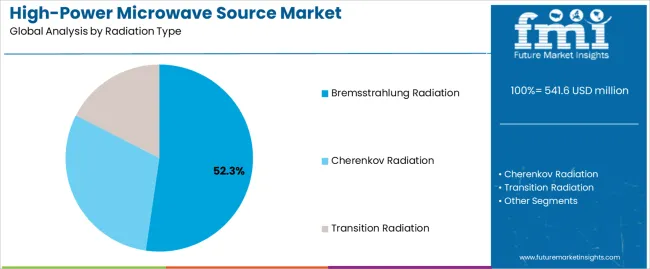
The bremsstrahlung radiation segment is projected to account for 52.3% of the high-power microwave source market in 2025, reaffirming its position as the leading radiation technology. Military applications and defense contractors increasingly utilize bremsstrahlung-based microwave sources for their superior electromagnetic pulse generation capabilities when operating across diverse electronic warfare scenarios, excellent penetration characteristics, and cost-effectiveness in applications ranging from radar jamming to electronic countermeasure systems. Bremsstrahlung radiation technology's advanced emission control capabilities and high-energy output directly address the military requirements for comprehensive electronic disruption in modern battlefield environments.
This radiation segment forms the foundation of contemporary defense electronic systems, as it represents the technology with the greatest electromagnetic effectiveness and established market demand across multiple application categories and defense sectors. Manufacturer investments in enhanced cathode technologies and automated beam control compatibility continue to strengthen adoption among defense contractors and military organizations. With organizations prioritizing electromagnetic superiority and operational effectiveness, bremsstrahlung-based microwave sources align with both performance requirements and strategic defense objectives, making them the central component of comprehensive electronic warfare strategies.
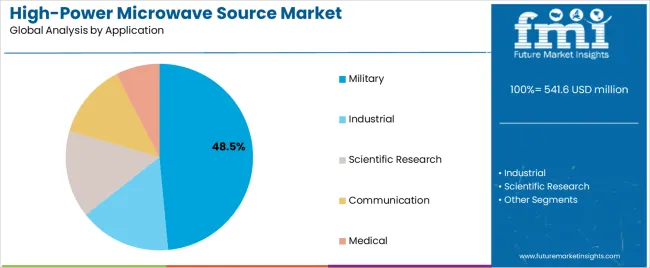
Military applications are projected to represent 48.5% of high-power microwave source demand in 2025, underscoring their critical role as the primary defense consumers of advanced electromagnetic technology for electronic warfare, radar systems, and directed energy weapon applications. Military operators prefer high-power microwave sources for their exceptional electromagnetic disruption capabilities, rapid deployment characteristics, and ability to disable electronic systems while ensuring operational effectiveness throughout diverse combat scenarios. Positioned as essential equipment for modern defense operations, high-power microwave sources offer both tactical advantages and strategic electromagnetic superiority benefits.
The segment is supported by continuous innovation in solid-state technologies and the growing availability of specialized frequency control systems that enable variable power output with enhanced beam precision and rapid frequency switching capabilities. Additionally, military organizations are investing in integrated weapon platforms to support large-scale electromagnetic warfare utilization and tactical planning. As directed energy weapon demand becomes more prevalent and electronic warfare requirements increase, military applications will continue to dominate the end-use market while supporting advanced defense automation utilization and electromagnetic dominance strategies.
The high-power microwave source market is advancing rapidly due to increasing demand for advanced defense technologies and growing adoption of solid-state microwave systems that provide superior electromagnetic performance and operational reliability while enabling enhanced electronic warfare capabilities across diverse military and industrial applications. However, the high-power microwave source market faces challenges, including high development costs, stringent regulatory compliance requirements, and the need for specialized technical expertise and safety protocols. Innovation in gallium nitride semiconductors and AI-powered frequency management continues to influence product development and market expansion patterns.
The growing adoption of solid-state amplifiers, gallium nitride semiconductors, and advanced thermal management systems is enabling manufacturers to produce high-power microwave sources with superior efficiency characteristics, enhanced reliability, and compact form factor functionalities. Advanced solid-state systems provide improved electromagnetic performance while allowing more efficient heat dissipation and consistent power output across various frequency bands and operational conditions. Manufacturers are increasingly recognizing the competitive advantages of solid-state microwave capabilities for operational differentiation and premium market positioning.
Modern high-power microwave source producers are incorporating ai-powered beam steering, automated target tracking, and integrated weapon control systems to enhance operational intelligence, enable predictive maintenance capabilities, and deliver value-added solutions to defense customers. These technologies improve combat effectiveness while enabling new operational capabilities, including real-time threat assessment, electromagnetic effect optimization, and reduced operator workload. Advanced AI integration also allows manufacturers to support comprehensive defense systems and military modernization beyond traditional manual electromagnetic warfare approaches.
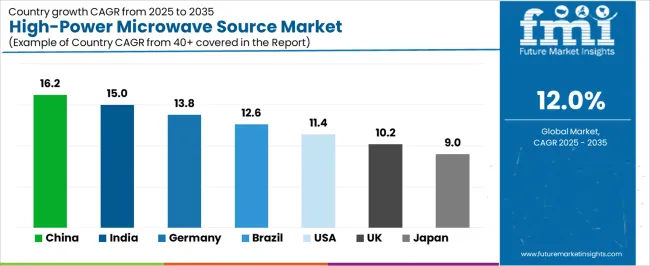
| Country | CAGR (2025-2035) |
|---|---|
| China | 16.2% |
| India | 15.0% |
| Germany | 13.8% |
| Brazil | 12.6% |
| USA | 11.4% |
| UK | 10.2% |
| Japan | 9.0% |
The high-power microwave source market is experiencing strong growth globally, with China leading at a 16.2% CAGR through 2035, driven by the expanding defense modernization programs, growing directed energy weapon development, and significant investment in electromagnetic warfare technology advancement. India follows at 15.0%, supported by military modernization initiatives promoting advanced radar systems, increasing defense electronics demand, and growing electronic warfare requirements. Germany shows growth at 13.8%, emphasizing defense technology innovation and advanced military system development. Brazil records 12.6%, focusing on military capability enhancement and defense technology modernization. The USA demonstrates 11.4% growth, prioritizing electromagnetic warfare standards and defense system excellence. The UK exhibits 10.2% growth, emphasizing defense technology adoption and military modernization development. Japan shows 9.0% growth, supported by advanced defense technology initiatives and precision military system concentration.
The report covers an in-depth analysis of 40+ countries; seven top-performing countries are highlighted below.
Revenue from high-power microwave sources in China is projected to exhibit exceptional growth with a CAGR of 16.2% through 2035, driven by expanding military modernization programs and rapidly growing directed energy weapon development supported by government initiatives promoting defense technology advancement. The country's strong position in semiconductor manufacturing and increasing investment in electromagnetic warfare infrastructure are creating substantial demand for advanced high-power microwave source solutions. Major defense contractors and research institutions are establishing comprehensive microwave development capabilities to serve both domestic defense demand and military technology export markets.
Revenue from high-power microwave sources in India is expanding at a CAGR of 15.0%, supported by the country's massive defense modernization sector, expanding government support for military technology development, and increasing adoption of advanced radar and electronic warfare solutions. The country's initiatives promoting defense technology self-reliance and growing military capability requirements are driving demand for advanced electromagnetic systems. International suppliers and domestic manufacturers are establishing extensive production and development capabilities to address the growing demand for high-power microwave source products.
Revenue from high-power microwave sources in Germany is expanding at a CAGR of 13.8%, supported by the country's advanced defense technology capabilities, strong emphasis on military innovation, and robust demand for high-performance electromagnetic systems in defense and aerospace applications. The nation's mature defense industry and technology-focused operations are driving sophisticated high-power microwave source systems throughout the military sector. Leading manufacturers and technology providers are investing extensively in solid-state systems and advanced frequency control technologies to serve both domestic and international markets.
Revenue from high-power microwave sources in Brazil is growing at a CAGR of 12.6%, driven by the country's expanding defense sector, growing military modernization programs, and increasing investment in advanced defense technology development. Brazil's strategic defense requirements and commitment to military capability enhancement are supporting demand for efficient high-power microwave source solutions across multiple defense application segments. Manufacturers are establishing comprehensive service capabilities to serve the growing domestic market and regional defense cooperation opportunities.
Revenue from high-power microwave sources in the USA is expanding at a CAGR of 11.4%, supported by the country's advanced defense technology sector, strategic focus on electromagnetic warfare capabilities, and established military innovation leadership. The USA's defense technology supremacy and system integration expertise are driving demand for high-power microwave sources in military applications, directed energy weapons, and advanced radar systems. Manufacturers are investing in comprehensive technology development to serve both domestic defense markets and international military export applications.
Revenue from high-power microwave sources in the UK is growing at a CAGR of 10.2%, driven by the country's focus on defense technology advancement, emphasis on military capability enhancement, and strong position in electromagnetic warfare development. The UK's established defense innovation capabilities and commitment to military modernization are supporting investment in advanced microwave technologies throughout major defense installations. Industry leaders are establishing comprehensive technology integration systems to serve domestic military operations and specialized defense applications.
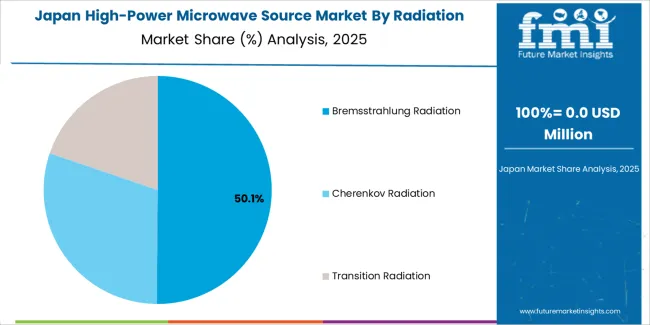
Revenue from high-power microwave sources in Japan is expanding at a CAGR of 9.0%, supported by the country's advanced defense technology initiatives, growing military modernization sector, and strategic emphasis on precision military system development. Japan's sophisticated technology capabilities and integrated defense systems are driving demand for high-power microwave sources in advanced radar applications, electronic warfare, and high-precision military systems. Leading manufacturers are investing in specialized capabilities to serve the stringent requirements of advanced defense technology and precision military industries.
The high-power microwave source market in Europe is projected to grow from USD 108.7 million in 2025 to USD 336.4 million by 2035, registering a CAGR of 12.0% over the forecast period. Germany is expected to maintain its leadership position with a 42.1% market share in 2025, declining slightly to 41.8% by 2035, supported by its strong defense technology sector, advanced military system capabilities, and comprehensive electromagnetic warfare industry serving diverse high-power microwave applications across Europe.
France follows with a 19.2% share in 2025, projected to reach 19.5% by 2035, driven by robust demand for high-power microwave sources in defense applications, military modernization programs, and advanced radar systems, combined with established defense technology infrastructure and electromagnetic warfare expertise. The United Kingdom holds a 15.8% share in 2025, expected to reach 16.1% by 2035, supported by strong defense technology sector and growing military innovation activities. Italy commands a 8.5% share in 2025, projected to reach 8.7% by 2035, while Spain accounts for 6.2% in 2025, expected to reach 6.3% by 2035. The Netherlands maintains a 3.8% share in 2025, growing to 3.9% by 2035. The Rest of Europe region, including Nordic countries, Eastern Europe, Belgium, Poland, and other nations, is anticipated to maintain momentum, with its collective share moving from 4.4% to 3.7% by 2035, attributed to increasing defense modernization in Eastern Europe and growing military technology penetration in Nordic countries implementing advanced defense system programs.
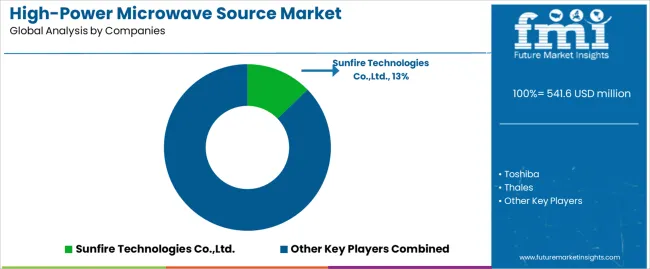
The high-power microwave source market is characterized by competition among established defense contractors, specialized electromagnetic technology producers, and integrated military system solutions providers. Companies are investing in solid-state technology research, power output optimization, frequency control system development, and comprehensive product portfolios to deliver consistent, high-performance, and application-specific high-power microwave source solutions. Innovation in gallium nitride semiconductors, ai-powered beam steering, and operational efficiency enhancement is central to strengthening market position and competitive advantage.
Sunfire Technologies Co., Ltd. leads the high-power microwave source market with a strong market share, offering comprehensive high-power microwave source solutions, including advanced solid-state systems with a focus on military and defense applications. Toshiba provides specialized semiconductor-based microwave capabilities with an emphasis on precision frequency control systems and automated beam management. Thales delivers innovative electromagnetic warfare products with a focus on high-power platforms and military system integration. CPI specializes in electronic tube technologies and high-power microwave systems for defense applications. GGEC focuses on advanced microwave generation equipment and integrated military solutions. Crescend offers specialized microwave platforms with emphasis on defense and aerospace applications.
| Items | Values |
|---|---|
| Quantitative Units (2025) | USD 541.6 million |
| Radiation Type | Cherenkov Radiation, Transition Radiation, Bremsstrahlung Radiation |
| Power Output | >10kW, 5-10kW, 1-5kW, <1kW |
| Application | Military, Industrial, Scientific Research, Communication, Medical |
| Frequency Band | X-band, Ku-band, Ka-band, S-band, Others |
| End-Use Sector | Defense Contractors, Research Institutions, Telecommunications, Industrial Manufacturers |
| Regions Covered | North America, Europe, East Asia, South Asia & Pacific, Latin America, Middle East & Africa |
| Countries Covered | China, India, Germany, Brazil, United States, United Kingdom, Japan and 40+ countries |
| Key Companies Profiled | Sunfire Technologies Co.,Ltd., Toshiba, Thales, CPI, GGEC, and Crescend |
| Additional Attributes | Dollar sales by radiation type and application category, regional demand trends, competitive landscape, technological advancements in solid-state systems, frequency control development, GaN integration innovation, and defense system integration |
The global high-power microwave source market is estimated to be valued at USD 541.6 million in 2025.
The market size for the high-power microwave source market is projected to reach USD 1,682.1 million by 2035.
The high-power microwave source market is expected to grow at a 12.0% CAGR between 2025 and 2035.
The key product types in high-power microwave source market are bremsstrahlung radiation, cherenkov radiation and transition radiation.
In terms of application, military segment to command 48.5% share in the high-power microwave source market in 2025.






Full Research Suite comprises of:
Market outlook & trends analysis
Interviews & case studies
Strategic recommendations
Vendor profiles & capabilities analysis
5-year forecasts
8 regions and 60+ country-level data splits
Market segment data splits
12 months of continuous data updates
DELIVERED AS:
PDF EXCEL ONLINE
Microwave Monolithic Integrated Circuits Market Size and Share Forecast Outlook 2025 to 2035
Microwave Cable Assemblies Market Size and Share Forecast Outlook 2025 to 2035
Microwave Oven Market Size and Share Forecast Outlook 2025 to 2035
Microwaveable Stuffed Animal Toys Market Size and Share Forecast Outlook 2025 to 2035
Microwave Ablation Devices Market Size and Share Forecast Outlook 2025 to 2035
Microwave Market Size and Share Forecast Outlook 2025 to 2035
Microwave Backhaul System Market Size and Share Forecast Outlook 2025 to 2035
Microwave Device Market Size and Share Forecast Outlook 2025 to 2035
Microwave-Safe Utensils Market Size and Share Forecast Outlook 2025 to 2035
Microwave Absorbing Material Market Size, Growth, and Forecast 2025 to 2035
Microwave Power Meter Market
Microwave Antenna Market
Microwave Source Market Size and Share Forecast Outlook 2025 to 2035
Commercial Microwave Ovens Market Analysis – Size, Share, and Forecast 2025 to 2035
Commercial Microwaves Market
Point-to-point Microwave Antenna Market Analysis by Polarization, Antenna Type, Diameter, Frequency Range and Region Through 2035
WiMAX (Worldwide Interoperability For Microwave Access) Market Size and Share Forecast Outlook 2025 to 2035
Outsourced Testing Services Market Insights – Trends & Forecast 2025 to 2035
Air Source Heat Pump Market Size and Share Forecast Outlook 2025 to 2035
Crowdsourced Security Market Size and Share Forecast Outlook 2025 to 2035

Thank you!
You will receive an email from our Business Development Manager. Please be sure to check your SPAM/JUNK folder too.
Chat With
MaRIA